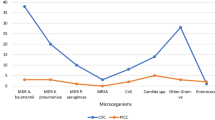Abstract
Objective
To determine the incidence ofMalassezia furfur-related colonization and infection of central venous catheters.
Design
Prospective clinical study.
Setting
A paediatric intensive care unit at a University Hospital.
Patients
66 newborns with central venous catheters for parenteral nutrition including lipid emulsions (Intralipid®).
Methods
When a central venous catheter was removed, it was rinsed with 1 ml of physiological saline, transported at ambient temperature to the clinical laboratory and cultured on Dixon's medium. The tip of the central venous catheter was used for a bacteriological study using Maki's technique. In case of suspected sepsis, blood cultures were obtained using an Isolator® tube.
Results
74 central venous catheters were included: mean duration of use of a central venous catheters and infusions of lipid emulsion (Intralipid®) were 19.3±10 days and 8.6±8 days respectively. Only 2 central venous catheters (2.7%) were colonized byMalassezia furfur: (Mf) one in an asymptomatic newborn, and the other in an infected newborn with signs of sepsis, who most probably died at 4 months of age from refractory hypoxia due to pulmonary hypoplasia, but not from Mf sepsis.
Conclusions
The incidence ofMalassezia furfur-related colonization of central venous catheters appears to be low but not negligible, which warrants the use of specific culture techniques.
Similar content being viewed by others
References
Powell DA, Hayes J, Durell DE, Miller M, Marcon MJ (1987)Malassezia furfur skin colonization of infants hospitalized in intensive care units. J Pediatr 111:217–220
Aschner JL, Punsalang A, Maniscalco WM, Menegus A (1987) Percutaneous central venous catheter colonization withMalassezia furfur: incidence and clinical significance. Pediatrics 80:535–539
Powell DA, Aungst J, Snedden S, Hansen N, Brady M (1984) Broviac catheter relatedMalassezia furfur sepsis in five infants receiving intravenous fat emulsions. J Pediatr 105:987–990
Long JG, Keyserling HL (1985) Catheter-related infection in infants due to an unusual lipophilic yeast-Malassezia furfur. Pediatrics 76:896–900
Dankner WM, Spector SA, Fierer J, Davis CE (1987) Malassezia fungemia in neonates and adults: complication of hyperalimentation. Rev Infect Dis 9:743–753
Marcon MJ (1986) Methods for optimal recovery ofMalassezia furfur from blood culture. J Clin Microbiol 24:696–700
Shaw JCL (1973) Parenteral nutrition in the management of sick low birthweight infants. Paediatr Clin North Am 20:333–358
Maki DG (1982) Infections associated with intravascular lines. In: Remington JS, Sartz MN (eds) Current topics in infectious diseases. McGraw-Hill, New York, pp 309–363
American College of Chest Physicians/Society of critical care medicine consensus conference (1992) Definitions for sepsis and organ failure and guidelines for the use of innovative therapies in sepsis. Critical Care Med 20:864–874
Faergemann J (1984) Quantitative culture ofPityrosporum orbiculare. Int J Dermatol 23:330–333
Azimi PH, Leverdier K, Lefrak LM, Petru AM, Barett T, Schenck H, Sandhu AS, Duritz G, Valesco M (1988)Malassezia furfur: a cause of occlusion of percutaneous central venous catheters in infants in the intensive care nursery. Pediatr Infect Dis J 7:100–103
Marcon MJ, Powell DA (1992) Human infections due toMalassezia spp. Clin Microbiol Rev 5:101–119
Redline RW, Dahms BB (1981) Malassezia pulmonary vasculitis in of infant on long term intralipid therapy. N Engl J Med 305: 1395–1398
Richet HM, McNeil MM, Edwards MC, Jarvis WR (1989) Cluster ofMalassezia furfur pulmonary infections in infants in a neonatal intensive care unit. J Clin Microbiol 27:1197–1200
Powell DA, Durrell DE, Marcon MJ (1986) Growth ofMalassezia furfur in parenteral fat emulsions. J Infect Dis 153:640–641
Powell DA, Marcon M (1987) Failure to eradicateMalassezia furfur Broviac catheter infection with antifungal therapy. Pediatr Infect Dis J 6:579–580
Author information
Authors and Affiliations
Additional information
This study was partially supported by a clinical research pilot study grant from INSERM France (91CN52)
Rights and permissions
About this article
Cite this article
Sizun, J., Karangwa, A., Giroux, J.D. et al. Malassezia furfur-related colonization and infection of central venous catheters. Intensive Care Med 20, 496–499 (1994). https://doi.org/10.1007/BF01711902
Received:
Accepted:
Issue Date:
DOI: https://doi.org/10.1007/BF01711902




